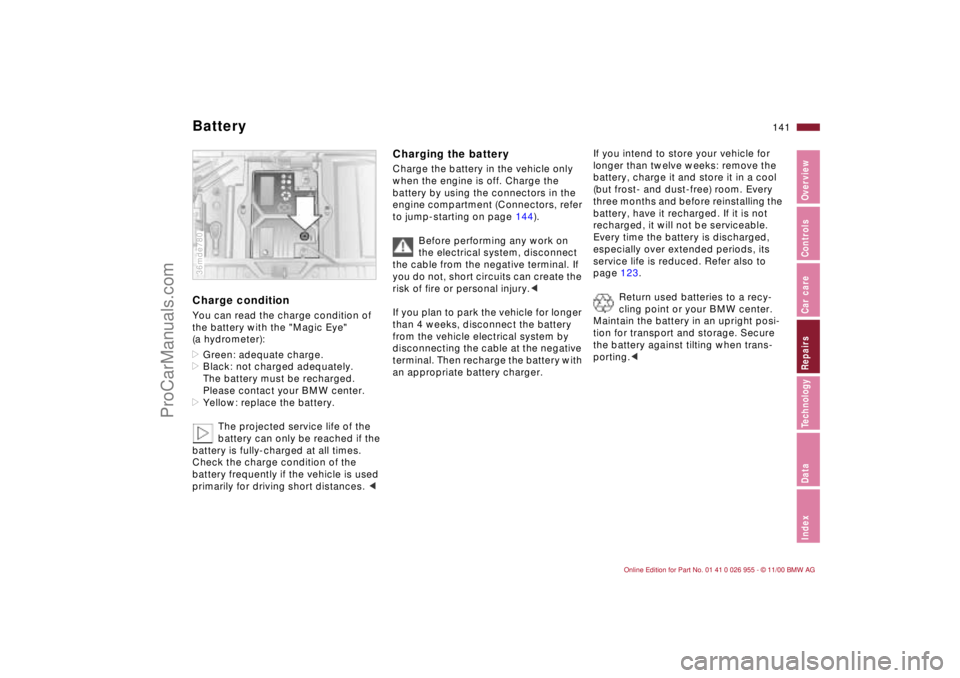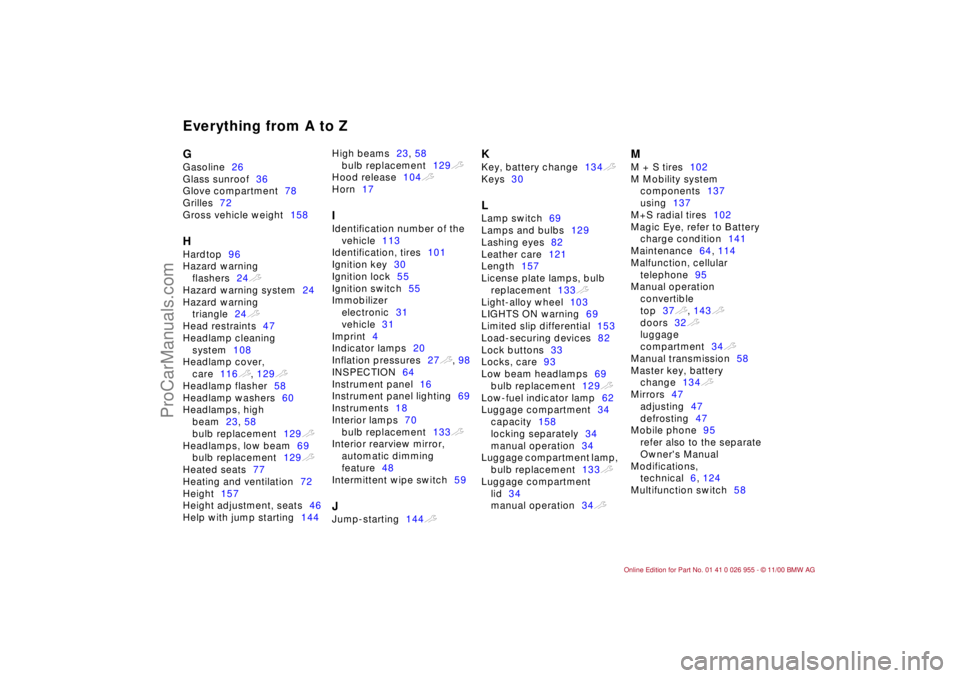2001 BMW M ROADSTER COUPE jump start
[x] Cancel search: jump startPage 12 of 171

Contents
Owner service procedures
Advanced technology
Technical data
Replacement procedures:
Onboard tool kit128
Windshield wiper blades128
Lamps and bulbs129
Master key with battery-
powered lamp134
Changing a wheel135
Repairing a flat tire135
Battery140
Fuses142
In case of electrical
malfunction:
Power convertible top143
Fuel filler door143
Assistance, giving and
receiving:
Jump-starting144
Towing the vehicle145Airbags150
Radio reception150
Dynamic Stability Control
(DSC)151
Safety belt tensioner151
Interior rearview mirror with
automatic dimming
feature152
Limited slip differential153Engine specifications156
Dimensions157
Weights158
Capacities159
Electrical system160
Drive belts160
ProCarManuals.com
Page 107 of 171

107n
IndexDataTechnologyRepairsCar careControlsOverview
Engine compartment1 Brake fluid reservoir112
2 Fuse box142
3 Coolant expansion tank112
4 Engine oil dipstick109
5 Engine oil filler neck109
6 Reservoir for windshield and
headlamp
* washer system108
7 Auxiliary terminal for jump-starting –
negative terminal144
8 Auxiliary terminal for jump-starting –
positive terminal144
ProCarManuals.com
Page 127 of 171

Overview
Controls and features
Operation, care
and maintenance
Owner service procedures
Technical data
Index Advanced technology
127n
IndexDataTechnologyRepairsCar careControlsOverview
Replacement procedures:
Onboard tool kit128
Windshield wiper blades128
Lamps and bulbs129
Master key with battery-
powered lamp134
Changing a wheel135
Repairing a flat tire135
Battery140
Fuses142
In case of electrical
malfunction:
Power convertible top143
Fuel filler door143
Assistance, giving and
receiving:
Jump-starting144
Towing the vehicle145
Repairs
ProCarManuals.com
Page 141 of 171

141n
IndexDataTechnologyRepairsCar careControlsOverview
BatteryCharge condition You can read the charge condition of
the battery with the "Magic Eye"
(a hydrometer):
>Green: adequate charge.
>Black: not charged adequately.
The battery must be recharged.
Please contact your BMW center.
>Yellow: replace the battery.
The projected service life of the
battery can only be reached if the
battery is fully-charged at all times.
Check the charge condition of the
battery frequently if the vehicle is used
primarily for driving short distances. < 36mde780
Charging the batteryCharge the battery in the vehicle only
when the engine is off. Charge the
battery by using the connectors in the
engine compartment (Connectors, refer
to jump-starting on page 144).
Before performing any work on
the electrical system, disconnect
the cable from the negative terminal. If
you do not, short circuits can create the
risk of fire or personal injury.<
If you plan to park the vehicle for longer
than 4 weeks, disconnect the battery
from the vehicle electrical system by
disconnecting the cable at the negative
terminal. Then recharge the battery with
an appropriate battery charger.
If you intend to store your vehicle for
longer than twelve weeks: remove the
battery, charge it and store it in a cool
(but frost- and dust-free) room. Every
three months and before reinstalling the
battery, have it recharged. If it is not
recharged, it will not be serviceable.
Every time the battery is discharged,
especially over extended periods, its
service life is reduced. Refer also to
page 123.
Return used batteries to a recy-
cling point or your BMW center.
Maintain the battery in an upright posi-
tion for transport and storage. Secure
the battery against tilting when trans-
porting.<
ProCarManuals.com
Page 144 of 171

144n
Jump-startingNever use spray starter fluids to start
the engine.
If the battery is discharged, the engine
can be started with the use of two
jumper cables and the battery of
another vehicle. Always use jumper
cables with fully insulated handles on
the terminal clamps.
Do not touch voltage-carrying
components when the engine is
running. To do so creates a risk of fatal
injury.<
Carefully comply with the following
instructions to avoid personal injury and
damage to one or both vehicles:
1 Ensure that the battery on the
support vehicle is also rated at
12 volts, and that the capacities of
the two batteries (Ah) are roughly
comparable (printed on casing).
2 Leave the discharged battery
connected to the vehicle electrical
system.
3 Make sure that there is no contact
between the bodywork of the two
vehicles. This creates the risk of
short-circuiting.
4 Start by connecting the jumper cable
from the positive terminal of the
support vehicle to the auxiliary
terminal for jump-starting located in
your BMW's engine compartment.
The cover of the auxiliary terminal for
jump-starting is indicated by a "+"
sign. Refer to the illustration. Flip the
cap forward to open.36mde793
5 Then connect the negative terminals.
First attach the cable to either the
support vehicle's negative battery
terminal "–", or to a suitable ground
on its engine or body. Then connect
the other terminal of the cable to a
ground on the engine or on the body
of the vehicle which is to be started.
This is a special nut which is provided
on the suspension strut dome of the
BMW. Refer to the arrow in the illus-
tration.
Follow the same sequence when
connecting jumper cables if you
are assisting another vehicle. If you do
not, there is a risk of personal injury
from spark generation at the battery.< 36mde794
ProCarManuals.com
Page 145 of 171

145n
IndexDataTechnologyRepairsCar careControlsOverview
Jump-starting Towing the vehicle6 Start the support vehicle's engine
and let it run.
7 Start the engine on the vehicle
needing the jump-start, and allow it
to run as usual. If the first start
attempt is not successful, wait a few
minutes before another attempt in
order to allow the discharged battery
to recharge.
8 Before disconnecting the jumper
cables from your BMW, turn on the
lamps, set the blower at the highest
speed and run the engine for at least
10 seconds. This will prevent a
voltage surge at the voltage regulator
to the electrical accessories.
9 Then disconnect the jumper cables in
reverse sequence.
If necessary recharge the battery.
Tow fittingThe screw-in tow fitting is stored in the
onboard tool kit; be sure that it remains
in the vehicle at all times. This fitting
is designed for installation in the tow
sockets located at the front and rear of
the vehicle, and is intended for towing
on paved road surfaces only.
It should not be used to pull a vehicle
out of deep snow, mud, sand, etc.
Comply with all applicable towing laws
and regulations at all times.Access to tow socketsFront:
Use a screwdriver to press the cover
out.36mde782
Rear:
Use a screwdriver to press the cover
out.
Screw the tow fitting in until it is
tight against the stop. If you do
not, the threads can be damaged.
Do not tow the vehicle by any compo-
nents of the running gear, or lash them
down in any way. If you do so, the
components could be damaged,
leading to possible accidents.<
Use only a nylon towing strap to tow
the vehicle, since the inherent resil-
ience of this material helps protect both
vehicles from sudden jerking move-
ments.36mde799
ProCarManuals.com
Page 146 of 171

146n
Towing the vehicle
The towed vehicle should always
be the lighter of the two vehicles.
If this is not the case, it will not be
possible to control vehicle handling.<
Tow-startingFor instructions on jump-starting, refer
to page 144.
Never attempt to use your vehicle to
push another vehicle, since damage to
the energy-absorbing bumpers could
result.
Towing a vehicle 1 Put the manual-shift gear lever in
neutral.
2 Towing speed:
45 mph (70 km/h) maximum.
3 Towing distance:
95 miles (150 km) maximum.
4 Leave the ignition key at position 1 to
ensure that brake lamps, turn signal
indicators, horn and windshield
wipers remain operative, and to
prevent the steering lock from
engaging.
5 Switch on the hazard warning
flashers (observe applicable legal
regulations).
Find some means of identifying the
vehicle in tow, for instance, place a sign
or warning triangle in the rear window.
Make sure that the ignition key
remains in position 1 even when
the electrical system has failed to
prevent the steering lock from
engaging.
The steering and brakes are without
power assist when the engine is off.
This means that increased effort is
required for steering and braking.<
Towing with a commercial tow
truck>Do not tow with sling-type equip-
ment.
>Use a wheel-lift or flat bed equip-
ment.
>Please comply with applicable towing
laws.
Never allow passengers to ride in
a towed vehicle for any reason.< 367us124
ProCarManuals.com
Page 166 of 171

Everything from A to ZGGasoline26
Glass sunroof36
Glove compartment78
Grilles72
Gross vehicle weight158HHardtop96
Hazard warning
flashers24t
Hazard warning system24
Hazard warning
triangle24t
Head restraints47
Headlamp cleaning
system108
Headlamp cover,
care116t, 129t
Headlamp flasher58
Headlamp washers60
Headlamps, high
beam23, 58
bulb replacement129t
Headlamps, low beam69
bulb replacement129t
Heated seats77
Heating and ventilation72
Height157
Height adjustment, seats46
Help with jump starting144High beams23, 58
bulb replacement129t
Hood release104t
Horn17
IIdentification number of the
vehicle113
Identification, tires101
Ignition key30
Ignition lock55
Ignition switch55
Immobilizer
electronic31
vehicle31
Imprint4
Indicator lamps20
Inflation pressures27t, 98
INSPECTION64
Instrument panel16
Instrument panel lighting69
Instruments18
Interior lamps70
bulb replacement133t
Interior rearview mirror,
automatic dimming
feature48
Intermittent wipe switch59JJump-starting144t
KKey, battery change134t
Keys30LLamp switch69
Lamps and bulbs129
Lashing eyes82
Leather care121
Length157
License plate lamps, bulb
replacement133t
Light-alloy wheel103
LIGHTS ON warning69
Limited slip differential153
Load-securing devices82
Lock buttons33
Locks, care93
Low beam headlamps69
bulb replacement129t
Low-fuel indicator lamp62
Luggage compartment34
capacity158
locking separately34
manual operation34
Luggage compartment lamp,
bulb replacement133t
Luggage compartment
lid34
manual operation34t
MM + S tires102
M Mobility system
components137
using137
M+S radial tires102
Magic Eye, refer to Battery
charge condition141
Maintenance64, 114
Malfunction, cellular
telephone95
Manual operation
convertible
top37t, 143t
doors32t
luggage
compartment34t
Manual transmission58
Master key, battery
change134t
Mirrors47
adjusting47
defrosting47
Mobile phone95
refer also to the separate
Owner's Manual
Modifications,
technical6, 124
Multifunction switch58
ProCarManuals.com